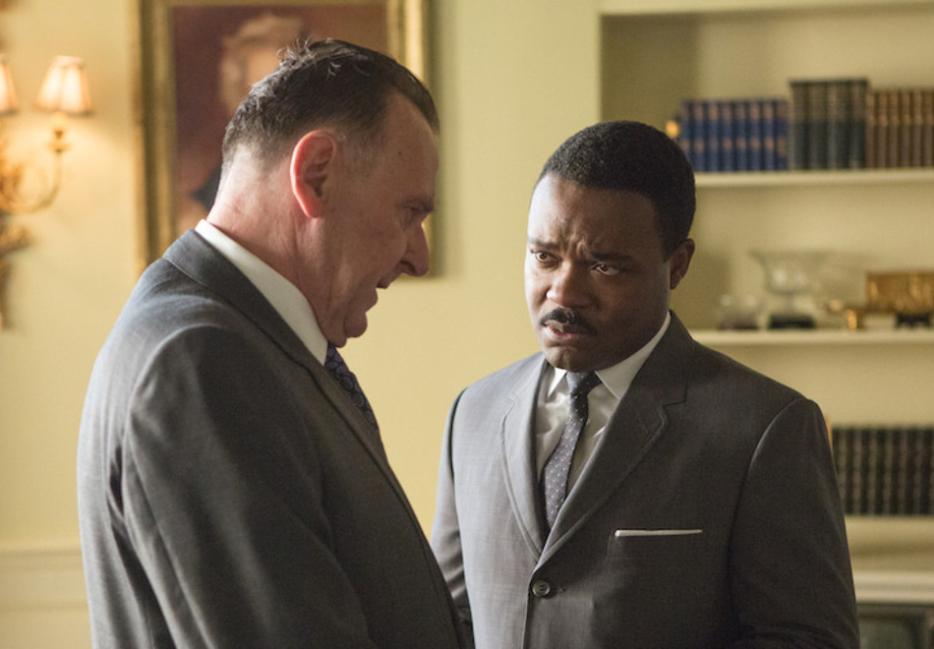Facts are the wreckage of history, not the vessels that carry it. The poster for Ava DuVernay’s new film Selma contains some clever misdirection: You see the back of Martin Luther King, Jr.’s head, framed ominously on both sides by Alabama State Troopers. But this was not the first attempted Selma march, where those cops savaged several hundred civil-rights activists with nightsticks, cattle prods, barbed wire, bullwhips and tear gas, nor the triumphant third one, a bugled and unbending convergence on the state capital Montgomery. In between, King led a smaller group across the Edmund Pettus Bridge, towards yet more police—and then the blue wall parted before them. Was it grudging surrender? A trap? DuVernay shows the hesitant reverend flicking his eyes back and forth, awed by this fire that licked away without a scorch, hunching down into prayer on the tarry road. He decides at last to turn the march around. The scene feels Biblical, but a gospel new to the standard canon.
The main cast of Selma is dominated by British nationals—David Oyelowo as King, Carmen Ejogo as his comrade and wife Coretta, Tom Wilkinson as Lyndon Johnson, Tim Roth as Alabama governor George Wallace—and they lack the dependence on Method-acting fervor some American actors have. They use physical shorthand beautifully. Oyelowo billows into the intensity of King’s oratory, those preacherly cadences and inverted Georgia wh sounds, but he does as much with reflective stillness, the way he leans against a wall while Mahalia Jackson sings through the phone. His performance reveals a man consumed by speaking in moments of silence. DuVernay made sure to invoke the reverend’s affairs and the anguish they caused his marriage, but she also finds intricacies during the opening scene, where King recites his Nobel Peace Prize speech in an uncertain and uncharacteristic monotone.
This particular President Johnson both aids and obstructs his counterpart’s goals, dismaying people who interpret movies in the same terms as a policy memo. In an appalling Washington Post column, the former Johnson aide Joseph Califano argued for a boycott, and also that his former boss sort of came up with the whole march idea. His citations don’t support that, but then scrupulous accuracy is not really the issue here. Attacking a historical drama for “embellishment” is like complaining that a painting distorts the ocean. If you want an exhaustive account of the civil rights movement, read Parting the Waters. The ultimate grievance seems to be that a president might be seen as the resentful object of pressure rather than a heroic patriarch, that DuVernay made Selma and not Washington. To watch a film by a black woman about black Americans seeking black liberation and fret for the white politician requires some exquisitely calibrated condescension.
Digressing from Lawrence of Arabia in The Devil Finds Work, James Baldwin wrote: “The English can be said to exemplify the power of nostalgia to an uncanny degree. Nothing the world holds, from Australia to Africa, to America, India, to China, to Egypt, appears to have made the faintest imprint on the English soul: wherever the English are is—or will resist, out of perversity, or at its peril, becoming—England. (Not, on the other hand, of course, that it can ever truly be England: but it can try.) … It would appear that this island people need endless corroboration of their worth: and the tragedy of their history has been their compulsion to make the world their mirror, this to a degree not to be equalled in the history of any other people—with a success, if that is the word, not to be equalled in the history of any other people.” And the U.S. presidency belonged for centuries to, as George Wallace might put it, Anglo-Saxons.
No one has published a newspaper op-ed defending the Alabama governor, one of the more fascistic personalities in American politics. Wallace adored the acquisition and demonstration of power, and whichever mode his racism took at any given juncture was opportunistic. His adviser John Kohn later said: “If George had parachuted into the Albanian countryside in the spring of 1962, he would have been head of a collective farm by harvest time, a member of the Communist Party by midwinter … and a member of the Comintern in two or three years.” Other Southern governors were parochial and familiar demagogues. In his study The Politics of Rage, Dan T. Carter argues that Wallace understood how to court the immigrant workers and Northern suburbanites who would otherwise sooner vote for Foghorn Leghorn—knowing that a system of white supremacy makes white people complicit in it. You could support segregation without actually identifying as a segregationist. Wallace took his 1968 presidential campaign to Chicago, where the neighbourhoods were delineated as starkly as piano keys, and spoke not of the tyrannical Lincoln but states’ rights, family values and social engineering.
Martin Luther King recognized how dangerous the grasping hole inside Wallace could be. He once told a reporter: “I am not sure he believes all the poison he preaches, but he is artful enough to convince others that he does.” King’s theory of nonviolence rested on political jiu-jitsu, forcing evil to expose itself. Flamboyantly theatrical, with a sadistic approximation of wit—after a radical leftist laid down in front of President Johnson’s limousine, he began to crow that his would keep on driving—Wallace also used public confrontation to his own ends. He offers few material explanations for stopping the march in Selma; he merely tells crony Al Lingo that he can’t abide the image of those “agitators” walking down an Alabama highway. Tim Roth gives Wallace the manner of a callow rockabilly singer, all swaying shoulders and blithe moues. Sitting across from Lyndon Johnson, he seems to be thinking: Hell, I could do this job.
Tom Wilkinson struggles more as LBJ—there’s something shriveled about his performance, like he was preoccupied trying to hold the accent together. You don’t get a sense of the man’s curiously sentimental cynicism, which allowed him to go from a practiced fiddler of “Dixie” to proclaiming “we shall overcome” on the Senate floor. The one amusing and telling moment is Johnson finally bringing a voting rights bill forward because Wallace infuriates him far more than King ever did, implying that this grand decision cascaded out of smaller immediate ones: Historiography as the field left effaced behind a freak avalanche. (“Stop thinking about 1965 and start thinking about 1985,” president snaps at governor, but in 1985 George Wallace would still be serving out his final term, and in 2015 the Supreme Court has rendered much of that Voting Rights Act unenforceable.)
Neither man is ultimately the focus of Selma, and nor at times is Martin Luther King. DuVernay means to show the collective mass of a whole radical movement. There are numerous scenes of other leaders debating tactics at planning meetings, or silently considering them. The legal inability to use King’s recorded speeches blurs perspective further; denied any famous rhetoric, the filmmakers have contrived elegant paraphrases, words that a marcher might hear in their head decades later. “I don’t think we remember it the same way,” King tells John Lewis gently. Selma is a more analytical work than the conventional biopic, even slightly detached: The ironic intertitles all mimic FBI surveillance files. (J. Edgar Hoover himself gets a single cameo, his voice clicking and whirring like a damaged tape recorder.) Shot by DuVernay through enveloping tear gas, Bloody Sunday’s brutality seems uncanny and ethereal, violence lunging out from the smoke of history.
Some of the supporting characters will be familiar: King’s former rival Malcolm X turns up, chastened, penitent, haunted by death. But many would never receive a movie of their own, people like Annie Lee Cooper, who lost her job after trying to register as a voter and endured a police beating when she punched out the vicious Alabama sheriff Jim Clark. Or people like Cager Lee, who was born in 1883, the son of a slave. During a civil-rights march near Selma, while state troopers clubbed members of his family, Lee’s grandson Jimmie Lee Jackson tried to protect his mother; they shot and mortally wounded him against a cigarette machine. The cop responsible would later claim that Jackson tried to grab his gun, as cops always do. Once the state of Alabama finally convicted him in 2010—decades earlier, his victim lying in hospital, they had charged the dying man with assault and battery—he went to jail for five months.
The Cager Lee of Selma is played by Henry G. Sanders, a great actor seen most often on TV and in movie roles like “Foreman #2.” Before those, however, he starred in Charles Burnett’s Killer of Sheep, a 1977 neorealist film made for $10,000. The title character struggles against his job’s necroticizing routine at a Los Angeles slaughterhouse, as Burnett lingers on both his existential anguish and the brief handfuls of tenderness. In one lovely, fearful scene, Sanders and his wife slow-dance to Dinah Washington: “This bitter earth / Can it be so cold? / One day you’re young / Too soon you’re old / But while a voice / Within me cries / I’m sure someone / May answer my call…” It’s an image, or a predecessor, that DuVernay has studied. I thought of it again seeing Martin Luther King meet Cager Lee, proud face stricken by the grey light of the morgue, and Sanders adding he was a good boy in that high soft whisper, like a bird of paradise laying down to die.





